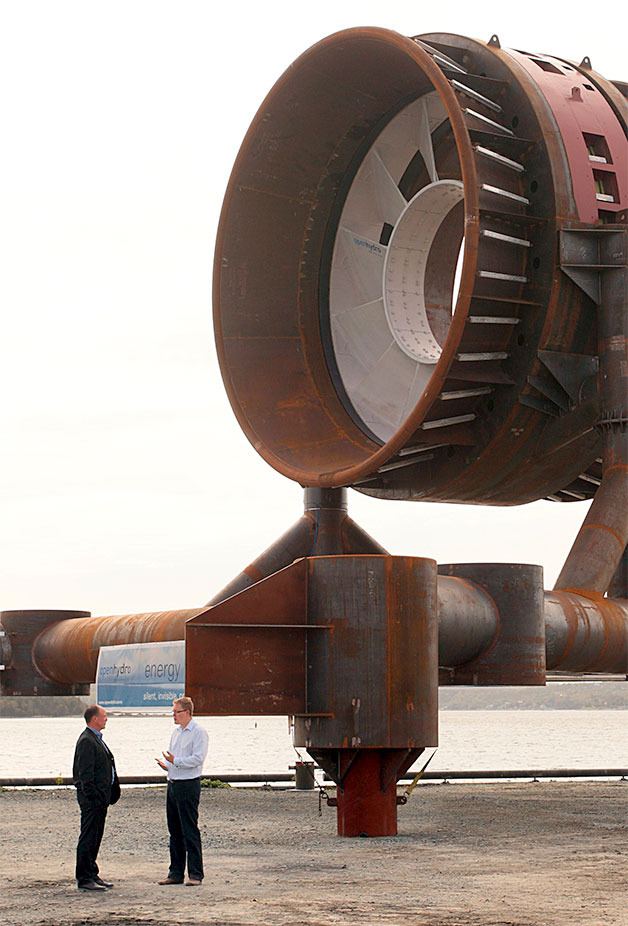By Kari Bray
Everett Herald
Confusion about a funding agreement contributed to the sudden end of an eight-year, multimillion-dollar tidal energy project in the waters off of Whidbey Island.
The Snohomish County Public Utility District announced Tuesday that it will no longer pursue a research project that would have placed two undersea turbines in Admiralty Inlet.
PUD officials said they cannot move forward because the U.S. Department of Energy decided not to fund a full 50 percent of the project.
Steve Erickson of Whidbey Environmental Action Network, however, said he believes a conflict with the company that owns a fiber-optic submarine cable system was what really doomed the project.
Pacific Crossings was laying the groundwork for a lawsuit, he said.
“They were not at all pleased with having the turbines 100 meters away from the cable, which is considered essential national infrastructure,” he said. “And rightly so.”
Both WEAN and Pacific Crossing filed as intervenors with Federal Energy Regulatory Commission after the PUD submitted a license application for the project.
Erickson said he’s obviously in favor of clean energy, but he prefers small-scale project over the “industrialization of the Puget Sound.”
The Department of Energy agreed in 2010 to share some of the costs. At the time, the project’s price tag was $20 million.
Now, both agencies dispute what they agreed to four years ago.
PUD General Manager Steve Klein says the DOE was going to pay half of the project cost, which was promised in a “gentlemen’s agreement.” DOE officials say their contribution was spelled out in a clearly framed contract, and they’ll give no more than $10 million — half of the project’s cost when the contract was signed.
Costs ballooned to $38 million. When DOE officials last week told the PUD they wouldn’t get anything beyond the $10 million, the PUD decided to kill the project.
The federal agency contributed $3.5 million in taxpayer money to the project before the plug was pulled.
“In our perspective, it was understood that they were a long-term partner,” Klein said. “Now, as we’re heading into the final go or no-go, they denied funding.”
Jose Zayas, director of the U.S. Department of Energy’s Wind and Water Power Technologies Office, last week denied a PUD request for an additional $8.85 million.
In an email to Klein, Zayas wrote that the DOE was committed to contributing the original $10 million.
“By maintaining this level of funding, the program is honoring our signed contractual agreement and maintaining the integrity of the competitive award process,” Zayas wrote.
He urged the PUD to consider “downscoping” the project to bring it back within budget. He also acknowledged the “burdensome review, licensing and permitting processes” PUD officials have cited as the main reason for cost hikes.
“It is my hope that we can find a path forward,” Zayas wrote.
The PUD has spent less than $8 million on tidal energy to date, with about $3.5 million coming from the Department of Energy, Klein said.
The deadline for contractors to bid on manufacturing and installing the turbines was Wednesday, the day after officials announced the end of the project.
Because the project is the first of its kind in the Pacific Northwest, and one of few around the world, the initial $20 million price tag was a rough estimate, Klein said.
Since 2006, the district has wrestled with a complex and expensive permitting and licensing process, Klein said. Unexpected fees, studies, delays and challenges, along with specific site and installation requirements, added up to more than expected.
Six months ago, the PUD received its final license and the OK to move forward with preparing an underwater site and installing the two 414-ton turbines.
The PUD has about a year to either start construction or rescind permits for the project. Officials plan to rescind.
Turbines to capture tidal currents to generate electricity were to be installed 200 feet underwater off the west shore of Whidbey Island.
Whidbey News-Times staff reporter Jessie Stensland contributed to this story.



